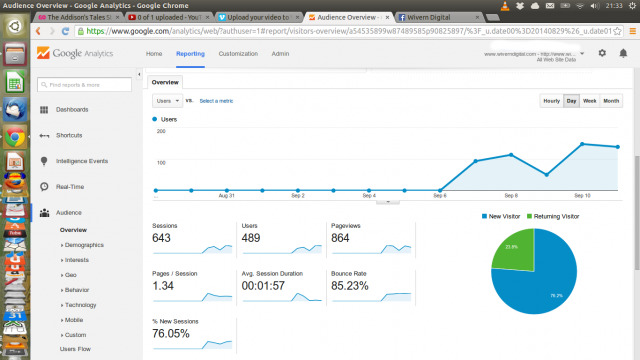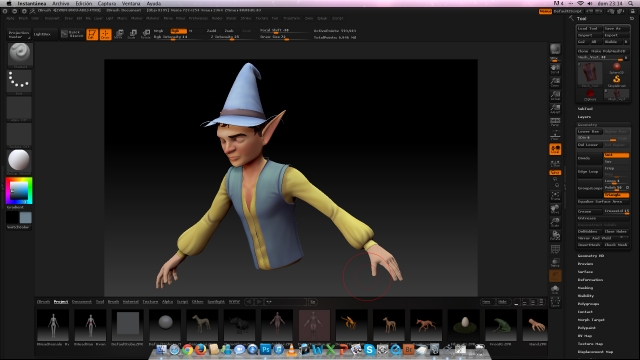Near the start of our reward-based crowdfunding campaign I wrote a piece for PVC outlining the ‘partnership approach’ we were taking to build exposure so that we could reach the desired ‘tipping point’ – that point where a key multiplier (popular press outlet or respected figure) might link to our campaign. Our Addison’s Tales campaign ends today. So what better time to reveal the highs, lows and the ‘what to do nexts’ so you can judge for yourself if the strategy we followed might be effective for your purposes or even how you can improve on it for your own campaign.
A Recap
The market idea I wanted to test with crowdfunding was whether readers would like to go deeper into a story character’s mind to learn facts or skills like music or English. Non-linear narrative, you might call it. Based on feedback before the campaign, it seemed like it was a good idea, but two questions I wanted to answer were: ‘had we packaged this core idea right, or does it need work; and if it needs an iteration or three, will it ever be sustainable?’
The reason I followed the partnership approach was principally driven by the fact that like many just starting out, my community was nearly entirely comprised of people who knew me personally. Making things tricky in terms of gaining public interest was the fact that our untested concept relied on unknown characters, which, as you’ll know from the publishing and movie world, is a tougher sell than using familiar characters or products. The really big hurdle, however, involved reaching a paying public in the high-end story app market, which presently is not very big and may never offer a return.
Answering this cheaply was why I put the idea and starting visuals on Indiegogo, where, with the correct preparation, any exposure we gained through the campaign would not be lost even if we didn’t reach the tipping point. In fact, the effort would actually work towards building awareness of the fledgling animation and storytelling company behind the idea. Did the approach work? Let’s see:
- SEO keyword-rich interview in leading international platform within key B2B market
- Interview in national government-run site frequently visited by firms and students (a key source of future high-end B2B demand and supply)
- Nomination in inaugural state crowdfunding prize
- An offer for incubation space
- Links from well-ranked media supporters in Australia, Germany, US, the Netherlands and Mexico
- A regular blog in PVC ; )
Did we reach a key multiplier with this approach and exposure? No. And I have a good idea why, but first I’ll explain how the first three were achieved, as a specific approach was required for these to occur.
Platforming
I explained our partnering approach in detail in my earlier post, but in summary, it firstly involves collecting funds before you start your campaign so that the first reach goal is transparently underwritten. You then use the reach goal concept to state what you are actually seeking. The upside with this approach is that it reduces risk in the eyes of potential partners, thereby increasing the likelihood that they give you platform time (either an interview or a link etc). That said, the reach goal concept is not hard wired into the platform code at present, and many potential backers will only look at the little green bar and the percentage. Those actually interested in your concept will read on and/or play the video to see that you are taking this approach to guarantee a minimalist product. So if you have reached your key market and they want your idea to happen, this is probably not be an issue. Others, however, will likely move on.
The second step is that if you are given any platform time to promote your idea as a result of your partnering approach, you should find a way to link or mention those who have helped getting your idea towards the public eye. Highly-ranked platform time, particularly on sites where advertising cannot be bought, is extremely valuable to all involved, because it acts a vote of confidence for your idea (and those somehow connected to it). Those mentioned will more than likely be happy to refer to the interview in their own public communication, thereby broadening exposure further. In that sense you are very much like a Master or Mistress of Ceremonies while running a campaign. So enjoy the stage time, but make sure you hat tip those who helped make it happen.
Timing
Major events, whether industry fairs or holiday events, can be harnessed to increase chances of being featured, as the webmasters may be looking for content from those doing something different around the theme. These featurings can be referred to when making further interview requests. If you are very lucky, published interviews may also bring you to the eyes of innovation prize nominees, as happened with us. The nomination leaves us in an interesting situation. Voting for the prize will occur after our campaign has finished, and feedback through the campaign suggests we really do need a prototype to show what’s envisioned. Responding to this feedback, one week into the campaign I added a diagram and an extra shorter video. But this is not the same as a prototype, which enables people to more clearly see the idea as being part of their own lives.
Running Successive Campaigns till you get it right?
Here I tip my hat to Etienne Garbugli. During a chat after a talk he gave, Etienne made the point that the idea from the days of print that “once something is done and printed, it’s done” no longer stands true in the digital age. Today, iteration is the name of the game. So there really is nothing wrong with going back, repackaging the core idea and pitching again. The question is whether investing in a prototype and makeover for a second pitch will help us reach the tipping point and therefore the screens of those who would be interested in our product. That’s a judgement call in an uncertain market. But let’s say feedback post-campaign suggests a second campaign, what would I do differently this time around?
Setting up for a campaign based on organic sharing
The partner approach we took for this campaign is really only suited to those unknown creators looking to build awareness to help test a new idea, and, as a flow on from this, to build exposure of the startup or creator behind the idea. It doesn’t suit those working with a little public exposure already, or those who may not need to leverage the exposure. Next time I would look at focusing solely on building organic sharing. A lot of good advice has already been written about this approach, but the best summary I have found so far comes from Jeff Hays. Instead of paraphrasing, I’ll just point you in his direction so you can get a full picture
In our case, here is what I’d do:
- create and test a basic prototype/screening with people in advance
- show users engaging with the prototype or screening in the pitch video
- if you can use familiar characters or products as a vehicle or reference for your idea, it will be easier. But if you want to introduce your own characters, consider using a familiar spokesperson. Rik Mayall, my all time favourite actor and comedy idol who gave me so much happiness as a kid, was to be that familiar figure after he agreed (and had apparently even loved) the script I sent his agent for the audio book of Tom Thorneval. Rik very sadly passed away two days before he was due to record in the studio
- during the campaign (and generally) provide Facebook fans with links to articles concerning the themes you deal with and that they will find useful (hat tip to Jere Suikkila here)
- consider a backer who would match the private donations up to a certain amount
- use more visuals to explain the concept to reduce word count by 50% (most of the talking will be done by the prototype anyway)
- create a list from personal contacts acquired in the past and during the campaign, and email twice before campaign starts
- use this list to find out what potential backers might like as a perk/reward – perhaps it has nothing to do with the product you are aiming to make!
- Remember that these days, everyone is a publisher – even you. So consider filming short interviews of others in your local industry. Make the theme one that will benefit others interested in the industry e.g. ‘how to make hardware less hard’. This will give you content for your social media that interviewees will send their networks to check out, while also giving your own fans a break from your spamming : ) You also build your network this way (hat tip to the senic.de boys for that one).
And that’s it. To finish, voting for Addison’s Tales will take place on this website between November 1 and 14, 2014*. If you like the idea, please give it a vote. I wish you the very best with your own crowdfunding project.
*Voters may have to scroll down to see the Addison’s Tales entry – then they can click on the heart next to it

Filmtools
Filmmakers go-to destination for pre-production, production & post production equipment!
Shop Now











